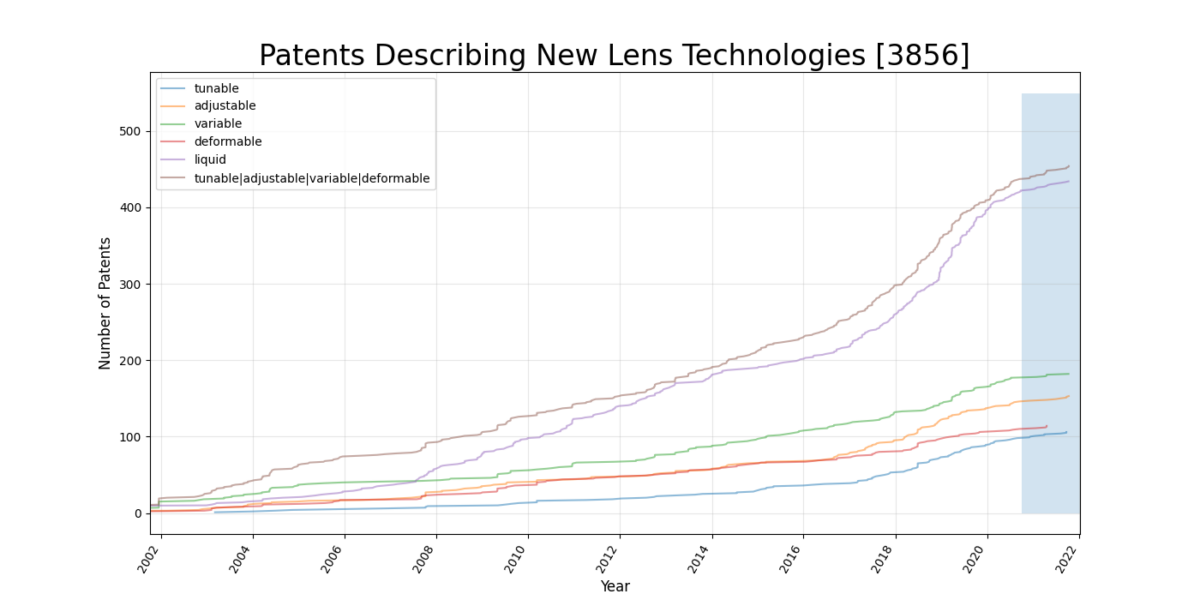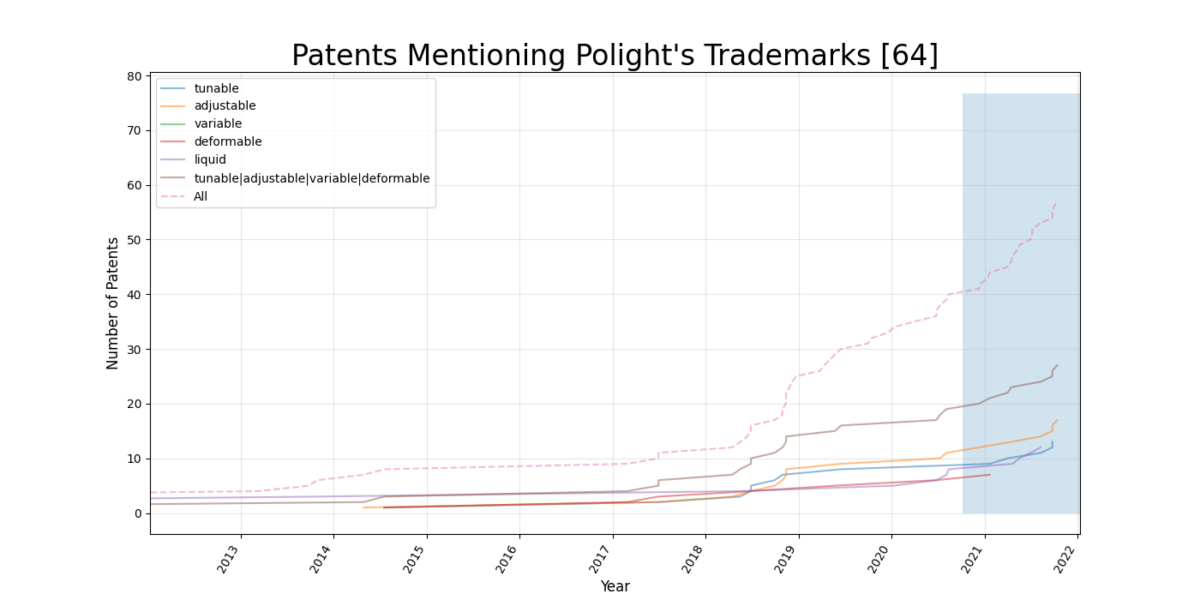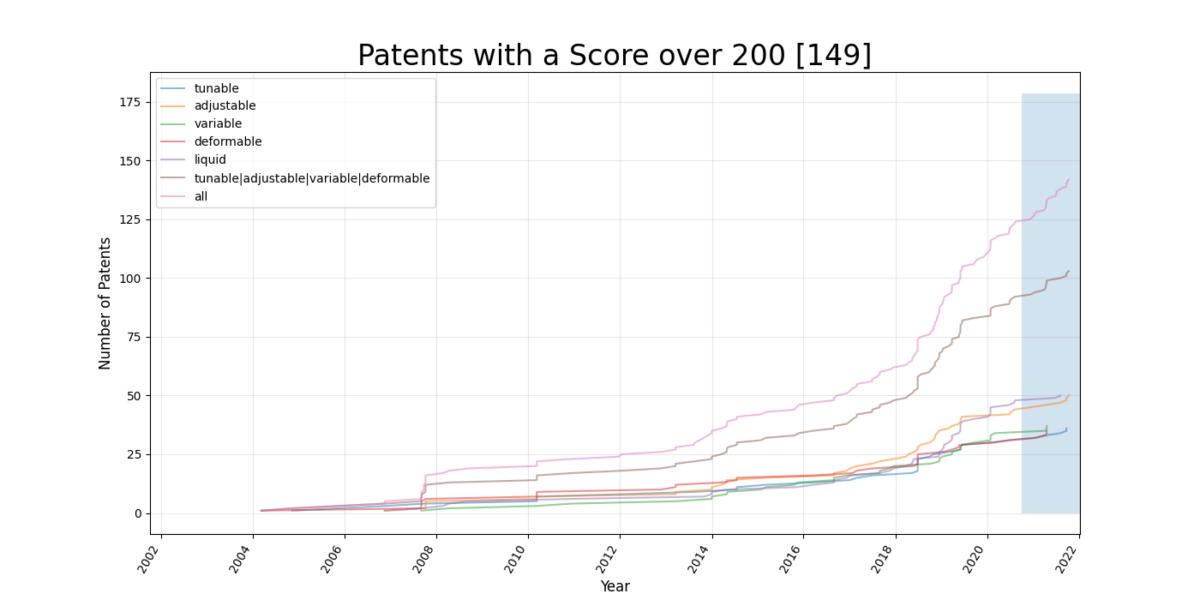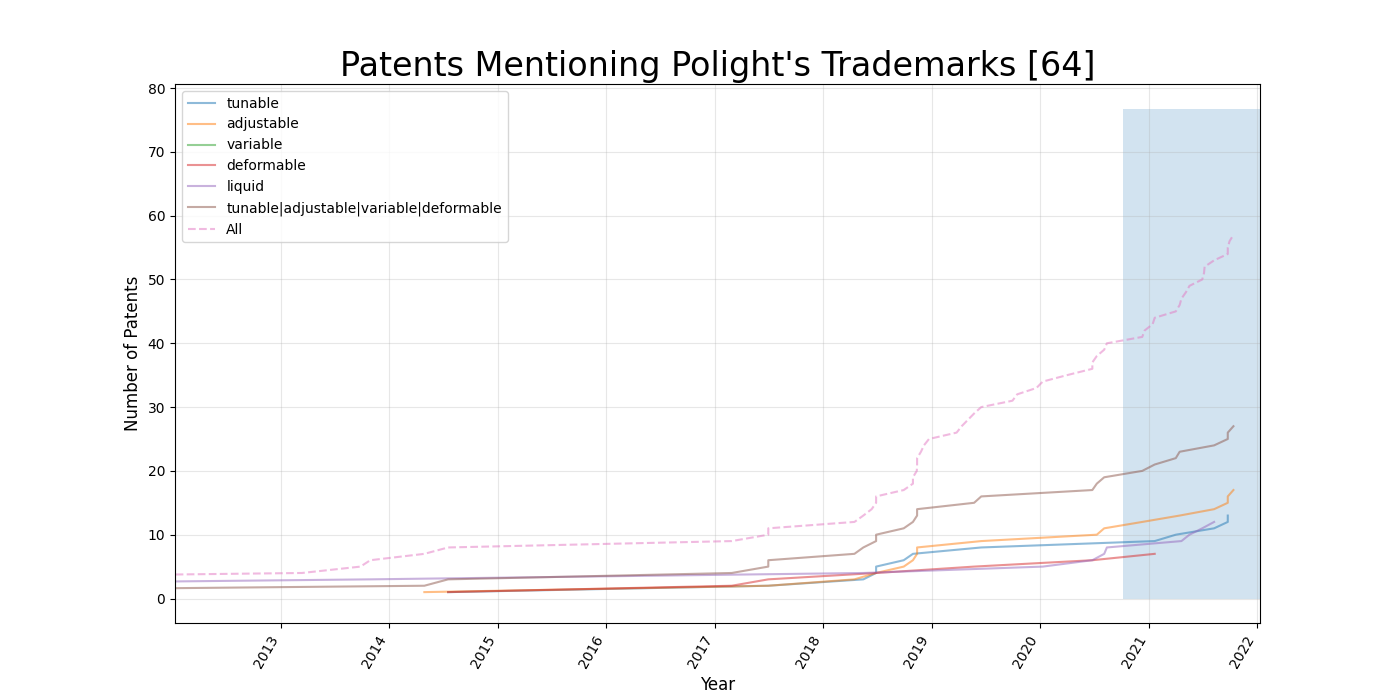Patent Analysis | Tunable Optics Trends
In this post we’ll quickly touch on how can we recognize tunable optics in patents by looking for keywords. Then we will look at the current development of the activity related to Tunable Optics by looking at cumulative patents and identify basic trends in how they are described in the patents.
Short Introduction to the Technical Nature of Tunable Optics
In order to obtain a variable focal plane for optics – the lens has to be adjusted. Tunable Optics is a term that includes optics that can be – well yeah – tuned in some shape or form. The major difference between conventional optics is that Tunable lenses modifies only the lens itself – whereas traditional solutions needs to use the reconfigure the whole lens assembly by using Voice Coil Motors (VCM). It has traditionally been easier to move about a set of lenses than it is to do super fast high precision modifications to lenses in demanding operational environments which is why we see the emergence of this technology first now. Having small tunable lenses that can operate in tough conditions does however open for many use-cases as it enables the use of auto-focus to provide better input data for photos, videos, light field data and other inputs that can drive the way for more intelligent solutions by providing best in class sensor inputs.
There three main categories of Tunable Optics as I am aware of at the time of writing:
- Liquid Lenses (Liquid Crystal Lenses)
- Shape Metal Alloys
- Polymer Lenses
By manually reading through a selected patents that mention these technologies we can begin to extract often used keywords that are used in relevant patent descriptions. There is a lot of creative descriptions – which makes it hard to only use a few keywords. So far we have found:
lensDescriptions = ["adaptive optics", "focus-variable lens", "tunable lens", "deformable lens", "adjustable lens","liquid lens", "focusing lens", "flexible lens", "polymer lens", "variable lens", "fluidic lens", "collimating lens", "autofocus lens", "auto focus lens"]
otherSolutions = ["fluid chamber", "pressurization", "electrowetting", "electro-wetting", "voice coil motor", "voice coil motors", "liquid crystal", "shape memory alloy"]
otherSolutions += ["VCM", "SMA", "LC", "LL"]These are initial keywords that can be used to see if a specific patent is of interest. otherSolutions is used as an aid to look for the occurrences of competing technologies to polymer-based tunable lenses. Ideas for more keywords is appreciated!
Cumulative Trend Analysis
Keywords of interested are extracted and plotted against time. The bigger the dataset (group) – the less important every single mistakes is. The smaller the dataset (group) – the easier it is to validate it. It is important to keep in mind that the scoring system (which we’ll write about later) is based on experience only – is continuously improved.
Selected Groups
From a given dataset produced by the crawler we divide it into several groups based on relevance. The more narrow the group is, the easier it is to validate the material. It is possible to split all groups into “published” and “granted” groups but we will only use “published” unless anything else is stated, based on a valid_unkind_unique dataset – meaning that all the patents have unique titles, inventors, are valid and don’t have any duplicates due to the same patent filed in multiple regions. In other words; most of these patents describe unique innovations.
- All the data (pre-sorted for validity and etc) – but a lot of irrelevant patents
- Score above 50 | Slightly relevant by gives a broad picture
- Score above 200 | Should be highly relevant for tunable optics
- Mentioning Polight’s Trademarks (TLens, Polight, All in Focus, Instant Focus)
Tunable Optics | Development from 2000-2022
Method: Using Group 1, Extracting keywords such as “adjustable lens”, “deformable lens”, “tunable lens”, “liquid lens”and “variable lens”

Figure 1: Counting all patents that uses these keywords (one count per patent) (last 18 months in blue)
It’s a clear upswing – that all types of tunable optics has experienced a boom around 2016. If you read my post about “Patent Time” you might now that we expect that over 50% of the patents following November 2020. We can adjust for this later to see how COVID affected R&D processes early 2020.
Trend Analysis for Patents Mentioning TLens
Method: Using Group 4, Extracting keywords such as “adjustable lens”, “deformable lens”, “tunable lens”, “liquid lens”and “variable” lens. Also plotting all patents in dataset as “all”.

This is interesting! We can see that adjustable lens (orange line) is preferred, tunable/liquid as close second place. Where is variable? The groups is exported as CSV files – so let’s inspect it to look for a possible explanation for the huge discrepancy between “all” and “tunable|adjustable…”.
The answer was found in the CSV file. Turns out that 22 of the patents don’t mention “lens” at all and the other ones uses a different keywords; namely “flexible”, “auto focus”, and “focusing” lens. We will save a proper keyword analysis for another rainy day – but it sure look interesting to dissect all the patents and look for trends!
Trend Analysis for Patents with a Score Higher Than 200
It’s a rather rare phenomenon that TLens was mentioned directly prior to early 2020 within the candidates (and a trend we’ll investigate later!) By using a score higher than 200 we’ll get a much bigger number of patents in our trend analysis and most of them mention components and usages such as “polymer”, “auto focus” in a way that has a very high probability to use Tunable Optics and open up for the possibility for TLens.

Remarks and Future Work
It’s safe to say that we can without a doubt see an accelerating interest for Tunable Optics in general. I’ve been using the year 2016 as the real starting point for this technological revolution as most of the “new” lens types began to dramatically accelerate. In hindsight – we can see that it really took off in 2019 where it seems like EVERYBODY and their grandmother started making patents, which surly must be an indicator of something!
At this point it should be obvious that the dataset-material is not mature nor the scoring subjected to a decent quality check. We’ll make sure that there is no bees by spending the next post extracting keywords from “good patents” and reworking the scoring system before we’ll do another and updated run – because, this is the heart and soul of the project and working with more than 6k patents won’t bring anything good at the moment! We’ll also use this opportunity to examine why we don’t catch a lens technology for all patents in the higher scoring datasets! (It’s pretty bad that we didn’t).
Happy easter!
